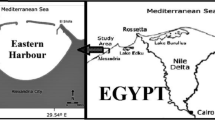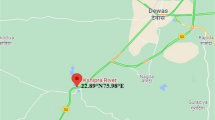Abstract
The decline in fish population because of water contamination is problem. As a result of direct exposure in water, it has been readily accepted that the gills are the main site of water contamination and toxicity (e.g., metal ions). In the present study, we investigated metal ion contamination on the functional capacity of carp gill cells with antioxidant interactions in an in vitro study. The extent of cellular membrane damage, lipid peroxidation (LPO) (as TBARS levels), and glutathione (GSH) content were investigated after the addition of two metal ion compounds (viz., CuSO4 and HgCl2) in various concentrations (300, 500, 700, 1000, and 3000 μM) to gill cell preparation of the freshwater fish carp (Cyprinus carpio L.) with modulations by bovine serum albumin (BSA) (0.5% and 1.0%) and dimethyl sulfoxide (DMSO) (0.5%) as free-radical scavengers. The Comet assay technique was also performed for the highest concentrations of the two mentioned metal ions as an index of DNA breaks. The outcomes were as follows: (1) Copper and mercury increased the rate of LPO dose dependently (r=+0.995 and r=+0.993, respectively; p<0.001), but the GSH content was only marginally affected (r=−0.787 and r=−0.844, respectively; p<0.05). (2) Depletion of GSH molecules by copper had a wider range than mercury. (3) In the highest concentration of metal ions (3000 μM), both DMSO and 1.0% BSA showed a pro-oxidative potential to elevate the levels of TBARS (p<0.001), but for other concentrations when supplemented with three scavengers, a fall in the levels of the latter was found. (4) The addition of 1.0% BSA to medium containing 3000 μM of metal ions caused a significant decline in GSH content (p<0.01). (5) Copper and mercury could cause a high rate of DNA breaks (single stranded) in carp gill cell suspensions as a Comet appearance.
These findings indicate that copper and mercury have a deleterious influence on membrane integrity and GSH content in a relatively dose-dependent manner. The complexes of metal ions and thiol (−SH) residues of cell proteins could also act as a potential cell toxicant leading to disturbances in cell functions causing cell death. DNA fragmentation is frequent in metal ion contamination.
Similar content being viewed by others
References
V. Karan, S. Vitorovic, V. Tutundzic, et al., Functional enzymes activity and gill histology of carp after copper sulfate exposure and recovery, Ecotoxicol. Environ. Safety 40(1/2), 49–55 (1998).
D. J. B. Dalzell and N. A. A. Macfarlane, The toxicity of iron to brown trout and effects on the gills: a comparison of two grades of iron sulphate, J. Fish Biol. 55, 301–315 (1999).
C. Hayes, R. G. Clark, R. F. Stent, et al., The control of algae by chemical treatment in a eutrophic water supply reservoir, J. Inst. Water Eng. Sci. 35, 149–162 (1984).
K. Radhakrishnaiah, A. Suresh, and B. Sivaramkrishna, Effect of sublethal concentration of mercury and zinc on the energetics of a freshwater fish Cyprinus carpio (Linnaeus), Acta Biol. Hung. 44(4), 375–385 (1993).
A. A. Radi and B. Matkovics, Effects of metal ions on the antioxidant enzyme activities, protein content and lipid peroxidation of carp tissues, Comp. Biochem. Physiol. C 90(1), 69–72 (1988).
D. Mukherjee, V. Kumar, and P. Chakraborti, Effect of mercuric chloride and cadmium chloride on gonadal function and its regulation in sexually mature common carpCyprinus carpio, Biomed. Environ. Sci. 7(1), 13–24 (1994).
A. Akahori, Z. Jozwiak, T. Gabryelak, et al., Effect of zinc on carp (Cyprinus carpio L.) erythrocytes, Comp. Biochem. Physiol. C 123, 209–215 (1999).
B. Halliwel and J. M. C. Gutteridge, Oxygen toxicity, oxygen radicals, transition metals and disease, Biochem. J. 219, 1–14 (1984).
R. K. Sharma and A. Agarwal, Role of reactive oxygen species in male infertility, Urology 98(6), 835–850 (1996).
A. Meister and M. E. Anderson, Glutathione, Annu. Rev. Biochem. 52, 711–760 (1983).
P. J. Hissin and R. Hilf, A fluorometric method for determination of oxidized and reduced glutathione in tissues, Anal. Biochem. 74, 214–226 (1976).
J. Matta, R. Hanger, and T. Tosteson, Heavy metal, lipid peroxidation and ciguatera toxicity in the liver of the carbibean barracuda (Sphyraena, barracuda), Biol. Trace. Element Res. 70(1), 69–79 (1999).
R. J. K. Anand, M. Arabi, K. S. Rana, et al., Role of vitamins C and E with GSH in checking the peroxidative damage to human ejaculated spermatozoa, Int. J. Urol. 7(Suppl.), S1-S98 (2000).
M. Lees, and J. Paxman, Modification of Lowry procedure for the analysis of proteolipid protein, Anal. Biochem. 47, 184–192 (1972).
H. Ohkawa, N. Ohishi, and K. Yagi, Assay for lipid peroxides in animal tissues by thio-barbituric acid reaction, Anal. Biochem. 95, 351–358 (1979).
J. Sedlak, and R. H. Lindsay, Estimation of total, protein-bound and nonprotein sulfhydryl groups in tissue with Ellman's reagent, Anal. Biochem. 25, 192–205 (1968).
N. P. Singh, M. T. McCoy, R. R. Tice, et al., A simple technique for quantitation of low levels of DNA damage in individual cells, Exp. Cell. Res. 175, 184–191 (1988).
A. Suresh, B. Sivaramakrishna, P. C. Victoriamma, et al., Shifts in protein metabolism in some organs of freshwater fish, Cyprinus carpio under mercury stress, Biochem. Int. 24(2), 379–389 (1991).
V. Z. Kurant, O. B. Stolyar, R. B. Balaban, et al., Effect of copper and lead on the nucle-oproteins and thiols in tissues of carp (Cyprinus carpio L.), Society for Experimental Biology Annual Meeting, 1997 (online).
J. G. Alvarez, and B. T. Storey, Differential incorporation of fatty acids into and peroxidative loss of fatty acids from phospholipid of human spermatozoa, Mol. Reprod. Dev. 42, 334–346 (1995).
C-H Huang, H. O. Hutlin, and S. S. Jafar, Some aspects of Fe2+-catalyzed oxidation of fish sarcoplasmic reticular lipid, J. Agric. Food Chem. 41, 1886–1892 (1993).
B. Halliwel, Oxidation of low-density lipoproteins: questions of initiation, propagation, and the effect of antioxidants, Am. J. Clin. Nutr. 61(Suppl.), 670S-677S (1995).
K. Eichenberger, P. Bohni, K. H. Winterholter, et al., Microsomal lipid peroxidation causes an increase in the order of membrane lipid domain, FEBS Lett. 142, 59–65 (1982).
I. Yuli, W. Wilbrandt, and M. Shinitzky, Glucose transport through cell membrane of modified lipid fluidity, Biochemistry 20, 4250–4258 (1981).
C. V. Smith, D. P. Jones, T. M. Guentiner, et al., Compartmentation of glutathione: implications for the study of toxicity and disease, Toxicol. Appl. Pharmacol. 140, 1–12 (1996).
M. K. Cha and L. H. Kim, Glutathione-link thiol peroxidase activity of human serum albumin—a possible antioxidant role of serum albumin in blood plasma, Biochem. Biophys. Res. Commun. 222, 619–625 (1996).
M. Tien, J. R. Bucher, and S. D. Aust, Thiol-dependent lipid peroxidation, Biochem. Biophys. Res. Commun. 107(1), 279–285 (1982).
S. N. Loh, L. A. Dethlefsen, and R. C. Fahey, Nuclear thiols: technical limitations on the determination of endogenous nuclear glutathione and the potential importance of sulfhydryl proteins, Radiat. Res. 121, 98–108 (1990).
R. A. Britten, J. A. Green, and H. M. Winenius, The relationship between nuclear glutathione levels and resistance to mephlalan in human ovarian tumor cells, Biochem. Pharmacol. 41, 647–649 (1991).
T. Guecheva, J. A. Henriques, and B. Erdtmann, Genotoxic effects of copper sulphate in freshwater planarian in vivo studied with the single-cell gel test (Comet assay), Mutat. Res. 497(1–2), 19–27 (2001).
L. Bucio, C. Garcia, V. Souza, et al., Uptake, cellular distribution and DNA damage produced by mercuric chloride in a human fetal hepatic cell line, Mutat. Res. 423(1–2), 65–72 (1999).
S. J. Stohs and D. Baghachi, Oxidative mechanisms in the toxicity of metal ions, Free Radical Biol. Med. 18(2), 321–326 (1995).
Author information
Authors and Affiliations
Rights and permissions
About this article
Cite this article
Arabi, M. Analyses of impact of metal ion contamination on carp (Cyprinus carpio L.) gill cell suspensions. Biol Trace Elem Res 100, 229–245 (2004). https://doi.org/10.1385/BTER:100:3:229
Received:
Accepted:
Issue Date:
DOI: https://doi.org/10.1385/BTER:100:3:229




